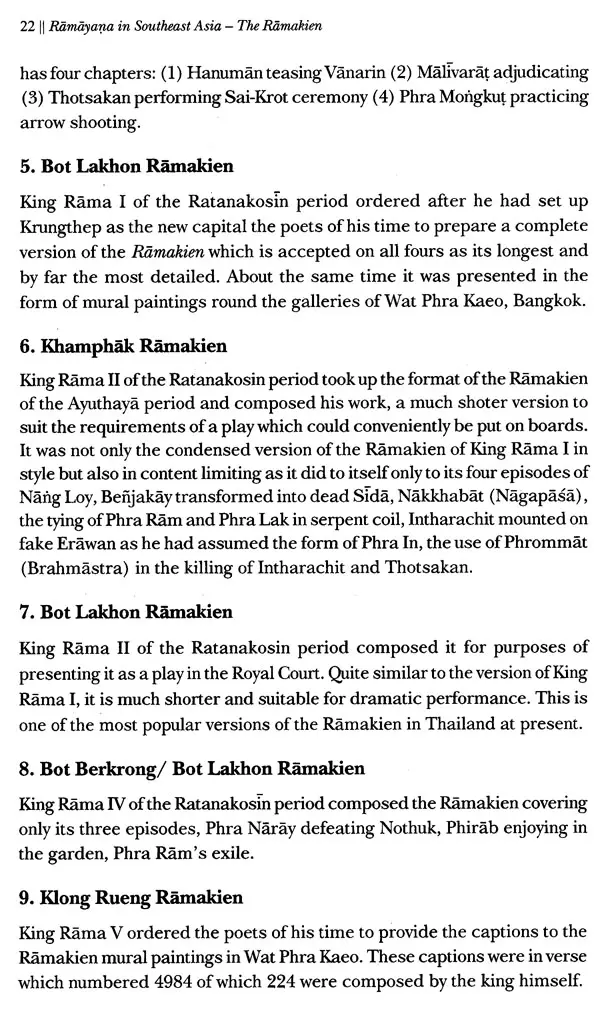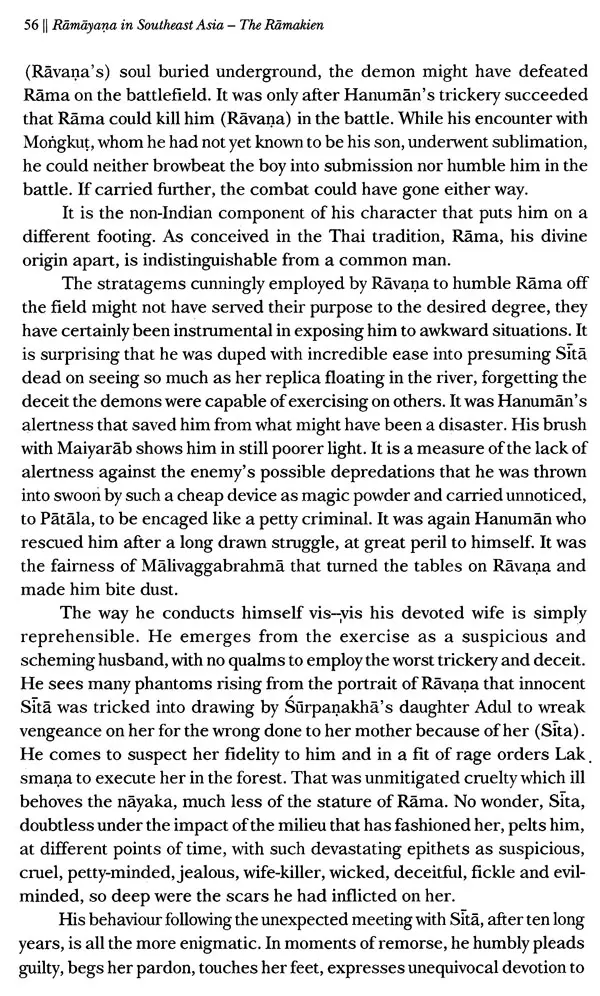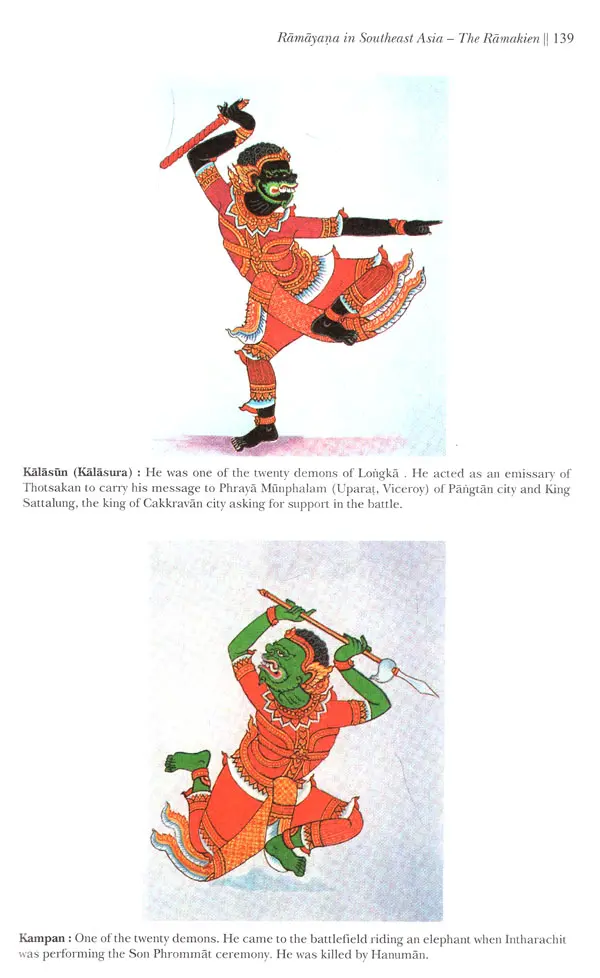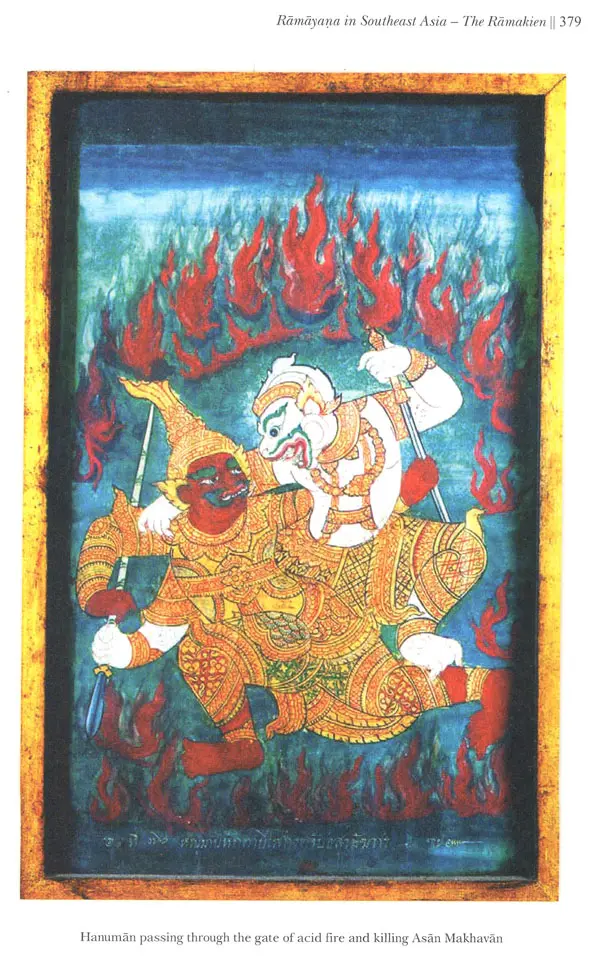
Ramakien Thai Ramayana- Ramayana in Southeast Asia
Book Specification
| Item Code: | UAM118 |
| Author: | Satya Vrat Shastri |
| Publisher: | SAHITYA AKADEMI, DELHI |
| Language: | English |
| Edition: | 2021 |
| ISBN: | 9789389778984 |
| Pages: | 440 (Throughout Color Illustrations) |
| Cover: | PAPERBACK |
| Other Details | 9.50 X 6.50 inch |
| Weight | 860 gm |
Book Description
Ramayana in Southeast Asia (Vol. I) : Ramakien (Thai Ramayana) -The first one among the series planned on the Rama story in Southeast Asia with every country of it having a version, sometimes more than one, the present Volume deals with the Rama story of Thailand called Ramakien. It differs from other versions of the story of the region as well as those of India to a large extent in introducing new episodes which are delineated in such a way as to give the story a unique form though adhering to the kernel of it.
The present volume deals with the Ramakien, Sanskrit Ramakirti, the Glory of Rama presented in literary form by several authors, interestingly, all kings. In art it figures in both its forms, performing: dance, drama, ballet, pantomime and plastic: paintings, sculptures, bas-reliefs, wood carvings and engravings on all sorts of objects. It also has deep imprint on Thai folklore.
A special feature of the present work is in depiction of the Ramakien characters numbering around 150 with a bewildering variety of their complexions, facial expressions, headgears, number of arms and heads and postures evidence par excellence of the way the Thai Muse had conceived them.
The Ramakien does not necessarily follow the Valmiki-Ramayana or other versions of the Indian Rama story. It takes an independent line in a number of cases by introducing new episodes not figuring in the former. The present volume deals with such episodes in extenso making every effort to trace their Indian roots from sources, Hindu, Buddhist, Jain and folklore, an attempt undertaken for the first time. It also brings to the fore differences, major and minor, between the Valmiki-Ramayana and the Ramakien while detailing the events. A unique feature yet again of this Volume is in presenting the detailed analysis of the Ramakien highlighting therein various rites and rituals practiced particularly by demons. In addition there is attention focused on the fact that names of plants and fruits, idioms and proverbs, beliefs and customs, have been drawn from the Ramakien.
The Author born on 29th September 1930, Prof. Satya Vrat Shastri had his early education under his father. Prof. Charu Deva Shastri. He was consistently top rank holder up to Post-Graduation and won University Medals. After doing his Ph.D. at the Banaras Hindu University he joined the University of Delhi where during the forty years of his teaching career he held important positions of the Head of the Department of Sanskrit and Dean of the Faculty of Arts. He was also the Vice-Chancellor of Shri Jagannath Sanskrit University, Puri, Orissa. He is the first recipient of the Jnanpith Award in Sanskrit, 2009. He got the Padma Bhushan Award in 2010.
He has the distinction of having been Visiting Professor in five Universities on three Continents. Among his many foreign students the most prominent is Her Royal Highness Maha Chakri Sirindhorn, the Princess of Thailand. He has attended and chaired a number of national and international conferences and seminars and delivered more than a hundred lectures in Universities and institutions of higher learning in Europe, North America, Southeast Asia and the Far East.
Both a creative writer and a literary critic, Prof. Satya Vrat Shastri has to his credit three Sanskrit Mahakavyas of about a thousand stanzas each, a Prabandhakavya, a Patrakavya (in two volumes), three Khandakavyas, the first ever diary in Sanskrit Dine Dine Yati Madiyajivitam and the first ever autobiography in Sanskrit (in three volumes) Bhavitavyanam Dvarani Bhavanti Sarvatva. The well-acclaimed critical work The Ramayana-A Linguistic Study which is the first ever linguistic appraisal of not only the Valmaki-Ramayana but of any extant Sanskrit work, Kalidasa Studies in three volumes: Kalidasa in Modern Sanskrit Literature (Poems), New Experiments in Kalidasa (Plays), Kalidasa-Inspired Sanskrit Poetry, five studies on Thailand: Sanskrit and Indian Culture in Thailand, Brahmanas of Thailand, Sanskrit Inscriptions of Thailand, Old Brahmanical Shrines of Thailand, Ramayaya in Southeast Asia-Ramakien (Thai Ramayana), Discovery of Sanskrit Treasures (Contd.) (in seven volumes), Sanskrit Studies-New Perspectives, Sanskrit Writings of European Scholars, Introducing New Works on Sanskrit, The Yogavasistha-A Linguistic Appraisal, Human Values-Definitions and Interpretations, Vol. I (Vol. II is under preparation), a century and a half of research articles and Forewords to 140 books are his contribution as critic. Travelogue is another area of his interest two of the more noteworthy works of his in this are Caran Vai Madhu Vindati (A Saga of Cultural Explorations in Foreign Lands) and Hungary-Kitani Dur Kitani Pas (Hungary : How Far and How Near). He has enormous experience as translator. He has translated A.A. Macdonell's A Vedic Grammar for Students in Hindi, Siramacaritadhiratnam of Nityananda Shastri in English, the thousand Subhasitas, wise sayings, the Subhasitasahasri in Hindi and English, the Canakyaniti in Hindi and English and the select poems in different languages of poet laureates of Europe in Sanskrit. He is the subject matter of twenty theses for the degrees of M. Phil. Ph.D. and D.Litt. in Indian Universities.
He is the recipient of one hundred and ten Honours and Awards, national and international, including Padma Shri, Padma Bhushan, President of India Certificate of Honour, Thai Royal Decoration. "The Most Admirable Order of Direk Gunabhorn", the Honour "Autorita Academische Italiano Straniere", the Civil and Academic Authority for Foreigners from the Govt. of Italy, the Medallion of Honour from the Catholic University, Leuven, Belgium, the Golden Prize from GESMEO, the International Institute of Advanced Asian Studies, Torino, Italy and five Honorary Doctorates from Indian and foreign Universities. In the Citation for the Honorary Doctorate at the Silpakorn University, Bangkok, he was described as "a living legend in the field of Sanskrit."
The present volume deals with the Rama story in Thailand called Ramakien. It is the first among the series planned on the Rama story in Southeast Asia.
For a start it may have to be borne in mind that it is not the same story in every country of the Continent. Even in India it is not so. Each country of Southeast Asia has a version; sometimes more than one; even a small country like Laos has four of them; which differ from each other to a large extent in introducing new episodes and delineate the story giving it a unique form, though adhering to the kernel of the same as summarized in a single stanza called the Ekasloki Ramayana, 'One-stanza Ramayana':
Adau Ramatapovanadigamanam hatva mrgam
kancanam
Vaidehiharanam jatayumaranam
Sugrivasambhasanam/
Valinirdalanam samudrataranam Lankapuridahanam Pascadravanakumbhakarnahananam etad dhi Ramayanam/
"First the visit to the hermitages etc. by Rama, (next) the killing of the golden deer, the abduction of Sita, the death of Jatayu, the pact with Sugriva, the decimation of Valin, the crossing of the ocean, the burning of Lanka, and lastly the killing of Ravana and Kumbhakarna. That is what the Ramayana is".
Now, coming to Thailand I may mention that I had an occasion to spend a number of years there as Visiting Professor of Indian studies first at the Chulalogkorn University and second time as Visiting Professor of Sanskrit at the Silpakorn University, both at Bangkok. Later I joined my wife who took over from me at the latter university. While in Thailand I came into contact with the Rama story in its various manifestations, in literature, in art in both its forms, performing; dance, drama, ballet, pantomime and plastic; painting, sculpture, bas relief, wood carving and depiction in all sorts of objects, the Chinaware, the cloth, the hand-fans, the trays, the lacquerware and so on and folklore. It is painted on the walls of Wat Suthat in the form of Triptychs, in the galleries of Wat Phra Kaeo, popularly called Temple of the Emerald Buddha in the form of miniatures, Wat Phya Nang in Phitsanulok in the form of murals. It is carved in the form of bas relief in Wat Phra Chetubon (jetuvana) , the Funerary Temple of the Royal family and has sculpted in stone some of its episodes in Prasad Panom Rung and Prasad Hin Pimai. Every other shrine in Thailand, though it may be Buddhist, has a scene or two, sometimes even more from it. This aroused my interest in acquainting myself thoroughly with it. I applied myself wholeheartedly to it. The result : The present study that presents an exhaustive overview of it in all its ramifications. The interest aroused in the story took me to other manifestations of it in countries around. The scope was widened. A project was open before me. I made a resolve to take it up and that too singlehandedly and that too again with my meager resources. I undertook extensive travels in most parts of Southeast Asia and was able to collect vast material which I decided to put in the form of a series of volumes, each volume dealing with each country. Except Vietnam and Brunei which have precious little of the Rama story, I have covered practically all countries of Southeast Asia which have a strong presence of the Rama story. Apart from the literary works that deal with it, the story finds delineation, as said above, in dance, drama, painting, and sculpture and bas relief. For a view of them I took photographs of them in whichever form I found the episodes from it represented. The result: I have a large collection of photographs of the story running well over to the astounding figure of over 2000. I know it is not possible to insert them in the body of the volumes for all the practical reasons. I had therefore to be selective, just to give a sample to the readers. The only exception has been in the Ramakien characters where I have reproduced the figure of each and every character numbering around 150 with a bewildering variety of their complexions, facial expressions, headgears, number of arms and heads and the postures, evidence par excellence as to how Thai Muse had conceived them. This collection includes photographs of even bulls, horses, elephants, birds and reptiles. There is reproduction of the story in the form of Hnang Yai in some details.
I am an avid reader of the Ramayana since my very early years. My contact with this great epic goes back to pre-natal period, a fact not known to me even until my revered father Prof. Charu Deva Shastri revealed it at a felicitation function in a Delhi University College after the announcement of the Sahitya Akademi Award for me in 1968 for my Sanskrit epic Srigurugovindasimhacaritam. He said that he had recited the whole of the Valmiki Ramayana to my mother when I was still not born in keeping with the practice current in traditional Indian families of the expectant mothers either reading themselves or being made to listen to the recital of some sacred text; it could be the Bhagavadgita or the Bhagavatam or the Ramayana or some hymns in praise of the deities so that the child in the womb could imbibe good samskaras even before he takes birth. He had pointed out that it was because of that that I had taken to composing Sanskrit poetry while there was no tradition of it in the family. It was due to this again that I had taken up for deep research the linguistic appraisal of the Valmiki Ramayana, a stupendous task involving as it did the study of the twenty four thousand stanzas of the voluminous work from all aspects, phonological, morphological, syntactical and semantical. It was again due to this that I took to composing the magnum opus, the twenty five canto Sanskrit Mahakavya the ,Sriramakirtimahakavyam on the Thai Ramakien, the Thai Ramayana which has several firsts to its credit : It is the first ever Sanskrit Mahakavya on any of the versions of the Rama story outside India; it is the first modern Sanskrit work that has been translated in seven Indian; Kannada, Assamese, Hindi, Gujarati, Telugu, Tamil, Malayalam and three foreign; English, Thai and French, languages; it is the first to win half a dozen Awards and Honours and has been at the centre of the most prestigious of them, the Jnanpith Award; it is the first to have become the subject matter of twelve Ph.D. Theses in Indian Universities. It is due to this again that I have taken up the most ambitious project of the study of the Rama story in seven countries of Southeast Asia of which the present study of the Ramakien, the Thai Ramayana forms the first volume.
There are ten versions of the Ramakien. The present volume gives an idea of each one of them.
While dealing with the Ramakien story a problem dogged me. It was the way names of the characters need mention in the present study. Some are drawn from Sanskrit, some are not. Some have one portion of Sanskrit origin and the other of Thai origin. Now, the question was: Are the Sanskrit-origin words to be converted to their original Sanskrit form or reproduced in their present Thai form that they have come to assume in accordance with Thai phonology. Should Thotsakan be written as Dasakantha and Thotsarot as Dasaratha, Phrot as Bharata, Lak as Laksmana, Satrud as Satrughna, Kaiyakesi as Kaikeyi, Sanuthraja as Sumitra, Vasit as Vasistha, Swamit as Visvamitra, Phiphek as Vibhisana, Khon as Khara, Thoot as Dusana and so on or in their Thai form as mentioned above along with their Sanskrit form. There was again a problem. Should they be reproduced the way they are pronounced or the way they are written-in Thai it is not uncommon to pronounce the same word differently and write it differently. I gave considerable thought to these questions. Finding no clear answer even from the more knowledgeable ones, I decided to fall back on my own judgment in line with Kalidasa's dictum; sandehapadesu vastusu pramanam antahkaranapravrttayah "in matters of doubt it is the inclinations of the mind which are the unerring authority". I opted for their mention in the form they are pronounced in Thai. This also went well with the non-Sanskrit names which also figure in good numbers or the words about which there is no surety about their original Sanskrit form. Wherever there was, their original Sanskrit form was mentioned in bracket, the very first time of their use of course and may be, sometimes repeatedly.
**Contents and Sample Pages**


























